To visit Austin is to experience an unparalleled air of content—students chirping about the University of Texas campus, joggers galloping around Town Lake, early risers grabbing brunch on Congress Avenue, night owls gallivanting on Sixth and Fourth streets.
Next time you’re in town, perform this experiment: Plant yourself on Congress or another of Austin’s main drags and ask a fair number of passersby if they’re enjoying themselves in the Lone Star State’s capital city. Dollars to donuts, the consensus from residents and visitors alike will land somewhere very close to, “Love it! Having a great time! Austin rules!”
In fact, if “positive praise via word of mouth” was a superlative among the many Austin annually garners—it is often found at the top of “best places to live, work and play” lists—it most certainly would rule. Austin’s good vibes are inherent (practically tangible) within the city’s reaches, and they also reverberate to the extent that people as far as New York and San Francisco, and everywhere in between, have a kind word to say about it even if they haven’t yet visited.
“There are no negative perceptions about Austin; we have built-in destination appeal, which makes us very attractive to planners,” says Roy Benear, senior vice president at the Austin CVB, adding that planners are overwhelmingly eager to learn more. “We hear from them a lot, ‘We have heard good things, but what do you have exactly?’ Since we have a great reputation, our work is getting the particulars about meeting here out to the industry—things like our convention center is technologically advanced and we have Wi-Fi downtown.”
Meetings Magnet
Numerous second- and third-tier destinations across the country are investing major bucks in their meetings infrastructure to attract more group business, and Austin is no exception.
The biggest news in this relatively new group destination—at its core is the 5-year-old Austin Convention Center and the even younger 800-room Hilton Austin located across the street—is a Marriott project that will spike the city’s room count.
Situated a short walk from the convention center, the 1,000-room Marriott Hotel Complex will include, under one roof, a 650-room Marriott, a 200-room Renaissance and a 150-room Springhill Suites by Marriott. Scheduled for completion in summer 2009, the three hotels combined will offer some 50,000 square feet of meeting space.
“Austin is positioned well for groups of 1,500 to 2,400 people,” Benear says. “We do host national groups and we’re pushing for more exposure. With a greater variety of properties,?by 2010 there will be 7,000-plus downtown rooms—we’ll be able to attract more groups.”
In addition to the Marriott development, several new hotels are either under construction or have been announced, including a highly anticipated W hotel, which will be part of the Block 21 real estate venture. Scheduled for completion in 2009, the $225 million project in the 2nd Street Retail District will also include 50,000 square feet of retail options, new studios for Austin City Limits and a nightclub co-owned by Willie Nelson.
“What makes Austin ‘Austin’ is its safety and walkability,” Benear adds. “We get clients here who have a preconceived notion that it’s a flat little Texas town, but it’s not flat, and we have so much going on.”
That’s Entertainment
Austin, whose popularity continues to grow, meets the demand for entertainment and attractions in order to live up to the expectations of local and visiting music fans, art aficionados, history buffs, and politicos.
“Austin has a cool factor,” Benear says. “It’s the home away from home for many celebrities, including Matthew McConaughey and Sandra Bullock [whose eatery, Bess Bistro, recently opened downtown].
“Austin is an emerging cultural destination, with established areas like Sixth, Fourth and Congress streets,” Benear adds, explaining that more go-to districts are appearing on Austin’s map.
The Austin Market District, for instance, opened last fall with the redevelopment and expansion of the former Whole Foods building, which still houses the city’s lone independent bookstore, BookPeople. The district also added various retailers and restaurants. Another large-scale redevelopment is taking place at Austin’s Seaholm Power Plant; the project will integrate the plant’s Art Deco facade into a new district of retail shopping, restaurants, and meeting and event space. Scheduled for completion in 2009, an upscale hotel will serve as the hub of the project.
One of the most noteworthy developments on Austin’s cultural landscape is the Blanton Museum of Art. The first phase of the museum complex opened last spring and the final phase is scheduled to open in early 2008. The multimillion-dollar facility is the cornerstone for the city’s first official Museum District, as it’s located on the University of Texas campus within a few blocks of the Bob Bullock Texas State History Museum, the LBJ Library and Museum, and the Texas Memorial Museum.
Sure, Austin has the fine arts, but not to be outdone, its music scene really is second-to-none.
For starters, the Long Center for the Performing Arts is currently under construction and scheduled to open in early 2008. The facility, which will provide a permanent home for performances of the Austin Symphony Orchestra, Ballet Austin and Austin Lyric Opera, will be the centerpiece of a 54-acre cultural park on the shores of Town Lake.
Plus, every night of the week, according to Benear, people can choose from 150 venues to hear live music, from Tejano to R&B.
“We even have a music department at the CVB to assist planners in booking bands for events,” he says.
Much like it is chosen for its music scene, some groups book Austin,?the most progressive city in Texas,?because of its politics, Benear maintains.
“We would save the salamander if you gave us a chance,” he jokes, adding that the city collectively mourned the death earlier this year of local Molly Ivins, a political commentator who consistently challenged the policies of President Bush.
Austin’s political leanings may have something to do with the “Keep Austin Weird” movement, which began in the South Congress area of town (where, in season, groups should most definitely check out the dusk flight of the famed Congress Street Bridge bats).
“Traditionalists here want to keep Austin’s funky-ness,” Benear says. “We prefer unique local cuisine, not chains, for example. It all makes Austin authentic.”
The Hills Are Alive
While Austin proper is evolving into a highly competitive top-tier meetings destination, the surrounding and quite scenic Texas Hill Country is home to several golf and spa resorts that cater to the group market as well.
Situated near Austin is Barton Creek Resort and Spa, a 303-room property on 4,000 acres with more than 43,000 square feet of flexible meeting and conference space, a luxury spa, and four golf courses.
“Barton Creek has been a bellwether for years,” Benear says.
At the Horseshoe Bay Resort Marriott, located on Lake LBJ about an hour outside of Austin, groups will appreciate Texas hospitality at its finest, as well as handsome accommodations and all the necessary amenities (see Property Profile).
Hill Country’s newest property, the Hyatt Regency Lost Pines Resort and Spa, opened last year roughly 13 miles from downtown Austin.
“It’s an absolutely beautiful property with a little different take on the resort idea, with equestrian opportunities, boating and fly-fishing,” Benear says of the 491-room property with 62,000 square feet of indoor meeting space.
Lastly, the 168-room Lakeway Resort and Spa, A Dolce Destination, completed a major renovation in 2006. Of particular interest to planners, the property features a new 5,200-square-foot, glass-windowed ballroom that juts out over Lake Travis.
For More Info
Austin CVB 512.474.5171
www.austintexas.org






